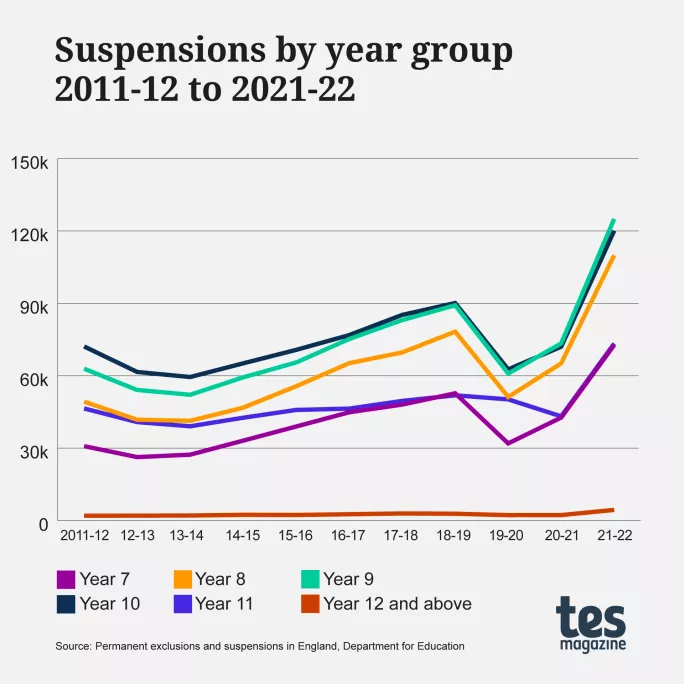The Hidden Costs Of School Suspensions: Long-Term Consequences For Students

Table of Contents
School suspensions encompass various forms, including short-term (a few days) and long-term (weeks or even months) suspensions, as well as in-school suspensions where the student remains on campus but is separated from regular classes, and out-of-school suspensions, requiring the student to stay home. Regardless of the type, the negative consequences of school suspensions are substantial and far-reaching, significantly impacting the lives of affected students and placing a heavy burden on society. Understanding the hidden costs of school suspensions is crucial for developing more effective and equitable educational practices.
Academic Impacts of School Suspensions: Falling Behind and Dropping Out
School suspensions directly and negatively affect academic achievement. The lost instructional time contributes significantly to learning loss, hindering students' ability to keep pace with their peers.
Missed Instruction and Academic Regression:
- Lost learning time: Even a few days of missed school can result in significant gaps in understanding, especially in subjects requiring sequential learning, like mathematics or science. This learning loss contributes to lower grade point averages (GPAs) and reduced academic achievement.
- Difficulty catching up: Students who miss class struggle to catch up on missed material, often falling further behind due to the cumulative effect of absences. Teachers, while dedicated, often lack the resources and time to provide individualized support for all students struggling to keep up.
- Increased risk of grade repetition and failure: Students with multiple suspensions are at a considerably higher risk of grade repetition, impacting their overall academic progress and potentially leading to academic failure. This cycle of failure reinforces negative attitudes toward school and exacerbates existing challenges. Low graduation rates are directly correlated with high suspension rates.
Increased Risk of School Dropout:
Repeated suspensions contribute to student disengagement and alienation from the school environment.
- Disengagement from school: Frequent suspensions disrupt the routine of learning and foster a sense of disconnect from school and its community. This feeling of being ostracized can lead to disinterest in academics and a reduced sense of belonging.
- Increased likelihood of dropping out: Students with a history of suspensions are significantly more likely to drop out of high school, limiting their future opportunities. Dropping out has profound and long-lasting effects on educational attainment and future life prospects.
- Long-term economic and social consequences: Dropping out of high school severely limits future economic opportunities, increasing the risk of unemployment, lower income, and reliance on social welfare programs. It also increases the likelihood of social marginalization. The ripple effects of high school dropout rates are felt across entire communities.
Social and Emotional Consequences of School Suspensions: The Ripple Effect
School suspensions have profound social and emotional consequences for students, creating a ripple effect that impacts their lives beyond the classroom.
Damaged Social Relationships and Isolation:
- Impact on peer relationships: Suspension disrupts social connections and can lead to damaged relationships with peers. Students may feel alienated and excluded, making it difficult to reintegrate into their social circles.
- Stigmatization and exclusion: Being suspended often carries a social stigma, leading to feelings of shame and isolation. Suspended students may face bullying or ostracization from their peers, further exacerbating their emotional distress.
- Increased risk of victimization: Students who are suspended may be more vulnerable to bullying or victimization, particularly if they lack a strong support system. This can create a dangerous cycle of negative interactions and increased social isolation.
Negative Impact on Mental and Emotional Well-being:
Suspension can significantly impact students’ mental and emotional well-being, increasing the likelihood of various behavioral and mental health issues.
- Increased risk of mental health issues: The stress, anxiety, and feelings of isolation associated with suspension can contribute to the development of depression, anxiety, and other mental health problems.
- Link between suspension and behavioral problems: Suspension can become a vicious cycle, where negative behaviors lead to suspension, which in turn can exacerbate behavioral problems and mental health difficulties.
- Importance of addressing root causes: To effectively address the negative consequences of suspension, it's crucial to identify and address the root causes of students' misbehavior, such as trauma, learning disabilities, or unmet social-emotional needs. Trauma-informed practices and mental health services are crucial for supporting these students.
The Long-Term Economic Costs of School Suspensions: A Societal Burden
The hidden costs of school suspensions extend beyond individual students, impacting society as a whole through increased economic burdens.
Reduced Earning Potential and Increased Unemployment:
- Correlation between education and income: Higher levels of educational attainment are strongly correlated with higher future earnings and reduced poverty. Dropping out severely limits this potential.
- Impact of dropping out on lifetime earnings: Students who drop out due to repeated suspensions face significantly lower lifetime earnings, contributing to income inequality. This gap can persist throughout their lives, having lasting implications on their financial well-being.
- Increased likelihood of unemployment and reliance on social welfare: High school dropouts are more likely to be unemployed or underemployed, increasing their reliance on social welfare programs, placing a significant financial strain on society.
Increased Crime Rates and Incarceration:
- Link between suspension and juvenile justice: There's a strong correlation between school suspensions and involvement in the juvenile justice system. Students who are frequently suspended are at a higher risk of engaging in delinquent behavior.
- Cycle of suspension, delinquency, and incarceration: Suspension can contribute to a cycle of negative behaviors that lead to further disciplinary actions and potentially involvement in the criminal justice system. This cycle can perpetuate disadvantage and increase societal costs.
- Societal costs of incarceration: The costs of incarceration, including the financial burden on taxpayers and the social impact of separating individuals from their communities, are substantial. Addressing the root causes of misbehavior in schools can significantly reduce this burden.
Conclusion: Rethinking School Discipline and Mitigating the Hidden Costs of Suspensions
This article has explored the significant hidden costs of school suspensions, demonstrating their devastating impact on students' academic achievement, social-emotional development, and long-term economic prospects. The consequences extend beyond the individual, placing a heavy burden on society as a whole. The data clearly shows that suspensions are not an effective solution for addressing student misbehavior.
Instead of relying on suspensions, schools need to adopt alternative disciplinary strategies that address the root causes of student behavior challenges. This includes restorative justice practices that focus on repairing harm and fostering reconciliation, positive behavior interventions and supports (PBIS) that promote positive behavior, and trauma-informed care that recognizes and addresses the impact of trauma on students' behavior.
Let's work together to reduce the hidden costs of school suspensions and create a more supportive and equitable learning environment for all students. We need to move beyond punitive measures and adopt approaches that foster student success and well-being, thereby reducing the long-term negative consequences of school suspensions. Investing in preventative measures and providing students with the support they need will ultimately benefit both the individual students and society as a whole.

Featured Posts
-
 Data Breach Millions Stolen Through Compromised Office365 Executive Accounts
May 03, 2025
Data Breach Millions Stolen Through Compromised Office365 Executive Accounts
May 03, 2025 -
 Barrow Afc Fans Cycle In Sky Bet Every Minute Matters Relay
May 03, 2025
Barrow Afc Fans Cycle In Sky Bet Every Minute Matters Relay
May 03, 2025 -
 Investing In Belgian Energy Storage A Case Study Of A 270 M Wh Bess Project
May 03, 2025
Investing In Belgian Energy Storage A Case Study Of A 270 M Wh Bess Project
May 03, 2025 -
 Liverpool Transfer News Frimpong Talks And Elliotts Future
May 03, 2025
Liverpool Transfer News Frimpong Talks And Elliotts Future
May 03, 2025 -
 1bn Funding Cut Forces Bbc To Confront Unprecedented Challenges
May 03, 2025
1bn Funding Cut Forces Bbc To Confront Unprecedented Challenges
May 03, 2025
Latest Posts
-
 Investigating The Economic Viability Of Offshore Wind Farms
May 04, 2025
Investigating The Economic Viability Of Offshore Wind Farms
May 04, 2025 -
 Why The Appeal Of Expensive Offshore Wind Farms Is Diminishing
May 04, 2025
Why The Appeal Of Expensive Offshore Wind Farms Is Diminishing
May 04, 2025 -
 Offshore Wind Balancing Costs And Sustainability
May 04, 2025
Offshore Wind Balancing Costs And Sustainability
May 04, 2025 -
 The Future Of Expensive Offshore Wind Energy Projects
May 04, 2025
The Future Of Expensive Offshore Wind Energy Projects
May 04, 2025 -
 Rising Costs Jeopardize Offshore Wind Farm Investments
May 04, 2025
Rising Costs Jeopardize Offshore Wind Farm Investments
May 04, 2025
